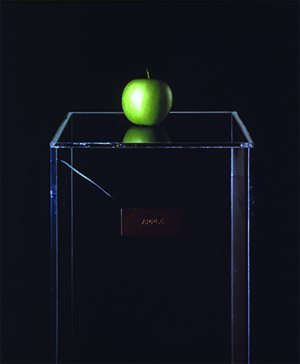
The Idea in the Work of Art
Apple (1966)
Apple, Plexiglas pedestal with brass plaque. Engraved: APPLE
“Idea’ is what the artist gives, like a stone thrown into the water for ripples to be made. Idea is the air or sun, anybody can use it and fill themselves according to their own size and shape of his body … Instruction painting makes it possible to explore the invisible, the world beyond the existing concept of time and space. And then sometimes later, the instructions themselves will disappear and be properly forgotten.” —Yoko Ono[1]
The work of Yoko Ono (b. 1933, Tokyo) is based on language, music, and philosophy. For Ono, art is idea, and she often uses words or verbal instructions to set a network of actions in motion that draw both the artist and the viewer into a maze of questions and reflections on life and existence.
In 1962 she presented Instructions for Paintings, which proposed a series of physical or mental exercises for the viewer to perform, thereby proving that painting can be separated into two different functions: instruction and realization. Instead of presenting the painting as a finished work, visitors were urged to perform actions in order to complete it. For example, viewers were invited to walk on Painting to Be Stepped On (1960 winter)or drip water onto Waterdrop Painting ( 1961 autumn).[2] Her art required the audience to take part in its development; far from static, it was the essence of transformation, change, and reflection.
In 1964 Ono published Grapefruit: A Book of Instructions and Drawings, a volume containing instructions for musical compositions, paintings, and performances meant to prompt an acoustic, visual, or physical experience of daily life that would reflect in everyday actions. Ono's instructions employ a wide variety of linguistic resources that "tend toward Minimalist form, emphasizing the sounds of words as well as their form and length. This clearly reveals her familiarity with Japanese haiku.” At times she resorts to absurdity and humor, and we often see evidence of her musical training and early studies in philosophy.[3]
Instructions for Paintings was a watershed in the history of Conceptual art in 1962. Art as object was replaced by art as idea, and the actual process of creating a work of art became paramount. And so language (both written and spoken), math, and numerology entered the realm of art.[4]
Ono occasionally materializes her ideas as simple, industrially produced sculpture objects from which she has removed all trace of emotion, in some ways similar to Minimalist sculpture. The piece entitled Apple (1966) is a green apple that rests on a Plexiglas pedestal bearing a brass plate engraved with the word "apple." In conceptual art, the idea and the work are the same thing, eliminating a perceptual encounter with unique objects in favor of engagement with ideas. However, as she juxtaposes an idea with the visual element, the image actually enhances rather than detracts from its poetic power.[5]
Meanwhile, her use of ordinary objects from everyday life ties in with the concept of the ready-made or found object advanced by Marcel Duchamp (b. 1887, Blainville-Crevon, France; Neuilly-sur-Seine, France, 1968), who turned mundane objects into works of art by taking them out of context. Ono offers experiences in which we are constantly being invited to participate through action or, as in Apple (1966), through reflection. These types of works speak to the innermost being, mirroring our private longings for solace and self-knowledge.
In 1988 Ono created a bronze version of her 1966 Apple, effectively solidifying the fresh apple.[6] Bronze, a material that Ono usually avoided in the 1960s, became meaningful in the 1980s: she began using it to reflect on the social and psychological situation of that era. The use of bronze indicates a desire on the artist's part to use the weight and solidifying power of her material to contrast the frivolity and transience of our materialistic age.[7]
- Alexandra Munroe, “Spirit of YES: The Art and Life of Yoko Ono,” YES YOKO ONO, exh. cat., Japan Society Gallery, New York (Oct. 18, 2000–Feb. 14, 2001), p. 22.
- Ibid., p. 21.
- Ingrid Pfeiffer, “Bringing the World into Balance,” Yoko Ono. Half-A-Wind Show. Retrospective, exh. cat., Guggenheim Museum Bilbao (Mar. 14, 2014–Sept. 1, 2014), pp. 27–28.
- Munroe, “Spirit of YES: The Art and Life of Yoko Ono,” pp. 24–25.
- Ibid., p. 31.
- Achille Bonito Oliva, “The Interactive Field of Art,” YES YOKO ONO, exh. cat., Japan Society Gallery, New York (Oct. 18, 2000–Feb. 14, 2001), p. 259.
- Ibid., p. 251.
Preguntas
Observe the work Apple (1966) and describe the elements that comprise it.
Apple is a popular fruit that often turns up in anecdotes, stories, works of art, designs, etc. Try to think of some examples.
What kind of ideas do we usually associate with the apple? If you had to use an apple as the image for a slogan, what kind of ideas would the apple convey? Why? What would the slogan be?
Observe the pedestal on which the apple is resting. What kind of material is it made of? Describe its characteristics. How would the work change if Ono had placed the apple on a table instead of a pedestal?
Ono put a plate engraved with the word “apple” on it. What does the plate with its inscription add to the sculpture?
Draw up a list of the characteristics that your students think a work of art should have.
